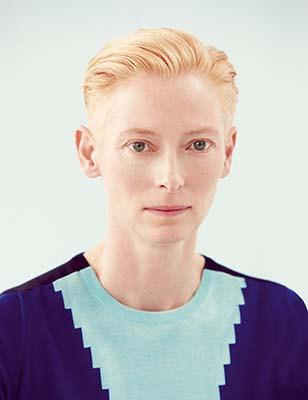
Tilda Swinton
In recent years, many designers, muses and stylists have worked with the concept of androgyny in their fashion campaigns, artworks or blogs. The media landscape, as well as the advertising landscape and the runway shows of today are full of androgynous looks.
While to many people it may seem obvious what androgyny is, the term actually has two meanings, one of them being the trend today, while the other is taking a back seat.
Definition
The dictionary defines androgyny as
“1. Biology Having both female and male characteristics; hermaphroditic.
2. Being neither distinguishably masculine nor feminine, as in dress, appearance, or behavior.”
Androgyny as a noun was first used around 1850, but the adjective androgynous was used even back in the 17th century and is derived from the older French (14th century) and English androgyne. The term was derived from Ancient Greek, where andr- means man and gyne means woman, through Latin, androgynous.
Androgyny in history
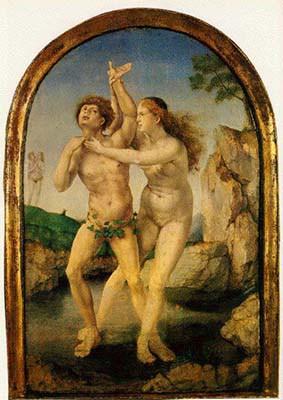
Salmacis and Hermaphroditos by Jan Mabuse
The concept of androgyny goes back to the earliest times. In Ancient Greece, there was a myth of Hermaphroditus and Salmacis, who were two divinities who fused into one single immortal being, which provided a frame of reference that was used in Western culture for centuries to come.
In Plato’s Symposium, Aristophanes tells the story of how people used to be spherical creatures, having two bodies that were attached back to back and who cartwheeled around. There were three sexes, the male-male people, who were said to have descended from the sun, the female-female people who were said to come from Earth and the male-female people who came from the moon. Of course, the last pairing represented the androgynous couple. According to the story, these sphere people tried to take over the gods, but failed. And so, Zeus decided to cut them in half and told Apollo to stich them back together, leaving the navel as a reminder to not defy the gods.
Other early mentions of androgyny come from the field of astronomy, where androgyn was a name that was given to a planet which was sometimes warm and sometimes cold.
Ancient philosophers such as Philo of Alexandria, as well as early Christian leaders such as Origen and Gregory of Nyssa promoted the idea that androgyny was humans’ original and perfect state.
In the Middle Ages in Europe, the idea of androgyny was a big part of the Christian theological debate as well as of the Alchemical theory. John of Damascus, John Scottus Eriugena and others promoted the idea of the early fathers of the church that humans were androgynous before the fall, while others debated and encouraged the treatment of androgyny.
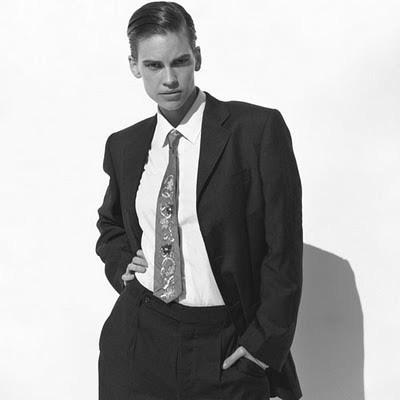
Hillary Swank
The Esotericism of the West continued to embrace the idea of androgyny in the modern period as well. In 1550, an anthology of Alchemical thought, called De Alchemia (About Alchemy) included the influential Rosary of the Philosophers (an alchemical treatise published in Frankfurt), which depicts the marriage of the masculine principle Sol with the feminine principle Luna, thus producing the “Divine Androgyne”, which was a representation of Alchemical Hermetic beliefs in transformation dualism and the transcendental perfection of the union of opposites.
Other mystics such as Jakob Böhme in Germany or Emanuel Swedenborg in Sweden (who is considered the father of New Age philosophies) were also preoccupied with androgyny.
In art, androgyny has also been a strong, yet subtle topic. Looking at many paintings from the Renaissance, one can notice that the characters are often neither male or female, or both male and female.
Androgyny in fashion
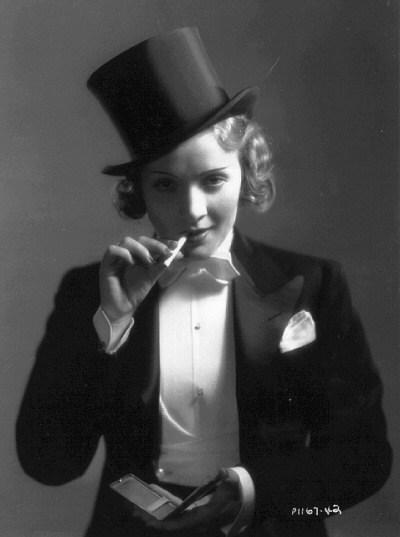
Marlene Dietrich
The history of fashion is strongly tied to the history of gender and sex. The reason is that clothing has always been used to define gender and its traits. Social rules have dictated throughout history how one should dress, based on their gender. Clothing was also encouraging or restricting certain activities that were assigned to a certain gender. For example, even if women wanted to ride on horseback or run, their clothes would not allow them to.
While the industrial revolution at the end of the 1800s brought some attention to the concept of blurring the lines between the genders, it was only after 1920 when the concept of androgyny began to be more mainstream. During the 1920s, it was often for people to play with gender expression, but it was more of a carnival concept, rather than a day to day choice.
The tumultuous and disastrous years that followed made people be more conservative and go back to old notions of gender expression. However, once peace was reinstated and the world began to regrow, androgyny saw a very strong rise.
It was during the 1960s when the lines between gender expressions started to be blurred and the women’s liberation movements across the 1970s changed the way we see men and women completely.
While androgyny has since always been a part of fashion, it has really began to be more preeminent after 2005 or so, when more and more designers adapted it and many people started to incorporate androgynous looks in their daily lives.
Androgyny today
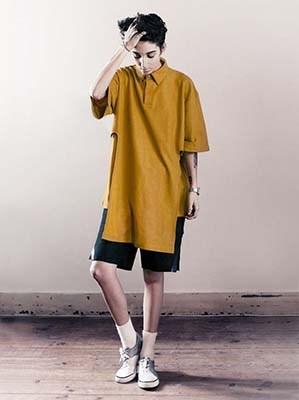
We definitely see the second type today almost exclusively.
In other words, people today don’t mix genders in a play of understanding male and female characteristics as the ancients, medievals or moderns did, but they deconstruct and destroy the concept of gender, resulting in a rather neutral image.
While it may not be very obvious, sexuality today is more taboo than it was 10 or 20 years ago and the constant obsessions we see today with identity might be some of the causes of this phenomenon. While non-gender-ism might be a concept that is interesting to explore, neutralizing an essential part of your identity can lead to harm in the long term. The obsession with gender and the heavy stir away from gender is also a mark of a cultural collapse, but this is something that remains to be seen for the moment.
While the West is playing with a non-gender version of androgyny, other cultures are also including it in daily life, but in different ways. For example, in far-East societies, such as Japan or Korea, we see many male K-pop stars working with extremely feminine fashions and styles, while still maintaining the idea of “man”, as opposed to “woman”.
Future androgyny
The future (or a big part of Western society at least) is definitely going to be androgynous for a good part, even though it might take some time and horrendous events to get there. The question that still needs to be answered however, is whether it will have a “both” approach or a “neither” approach. It’s most likely that the second version will be what will happen, as many people won’t explore the way you can work with both and will refuse the idea altogether. Some people will switch between genders easily and have a type of double life, especially as high-speed transportation will become more common, and gender expression might be a good part of this lifestyle.
This does not mean that everyone in the future will be androgynous. While it is quite sure that many people will probably want to have part of in some sort of androgyny, the future (at least the next decades) will probably be a time of high contrast. Conservative views of gender will coexist with gray area versions of gender and will probably rarely meet in a version of a public square. Religion will play an important role in the choices of people. At the same time, many people with conservative views of gender will have a double life where they have both a very conservative life and another life where they are either androgynous or of the opposite gender.
Androgyny has always been part of human nature and it will continue to have an important role in society, as things will change and develop. Our cultural approach to gender and sex is definitely going to have a word to say on how androgyny will be seen, whether it will become the main norm or whether it will only be one of the many norms of the future.
Fraquoh and Franchomme
Further reading:
Men and feminine clothes: A dichotomy?
Men and the color Pink: A cultural history
Women wearing men’s clothes: What do you think?
The Politics Of Dressing Up: Masculinity Vs Femininity
Toys, body image and gender roles
A debate: children’s clothes, ads and roles
P.S. We want to hear from you! What do you think of androgyny? Do you sport androgynous styles? What do you think will be the future of androgyny? Share your feedback, questions or thoughts in the comments below! For more articles on style, fashion tips and cultural insights, you can subscribe to Attire Club via e-mail or follow us on Facebook, Twitter or Instagram!

